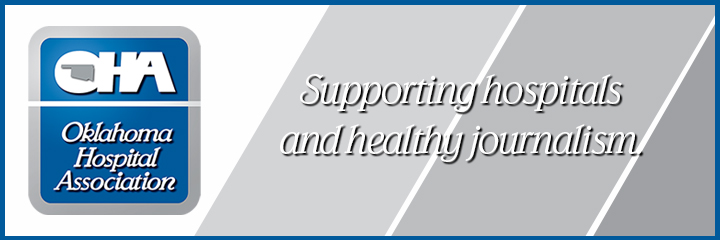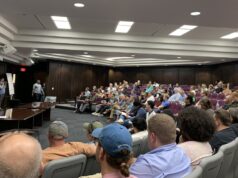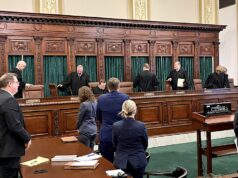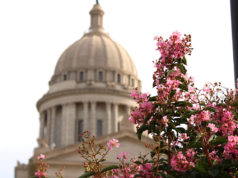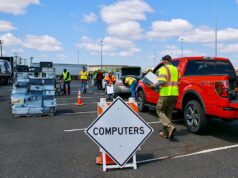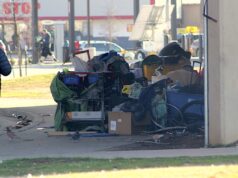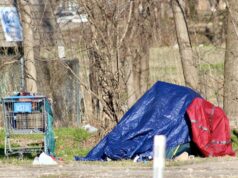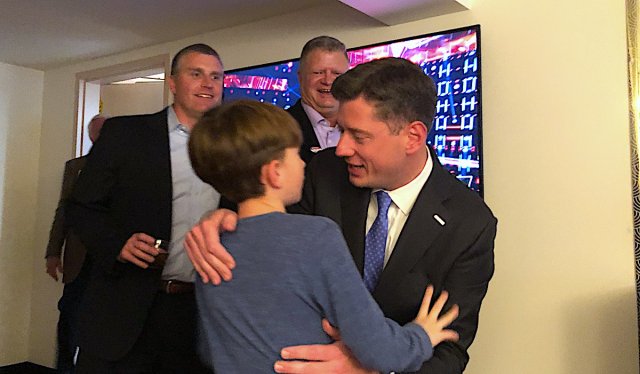

Oklahoma City’s latest installment of a penny sales tax for strategic investment passed with flying colors this evening. The city’s MAPS 4 package received 71.7 percent of the vote, making it the most popular of all MAPS votes.
“Tonight we have the largest percentage of support in the history of Oklahoma City,” Mayor David Holt told an assembled crowd in south Oklahoma City. “This is not just a victory. This is a mandate without historic precedent in our city. We have never been more united as one OKC.”
The nearly $1 billion package — which will fund a new outdoor arena, a new State Fairgrounds coliseum and improvements to the Chesapeake Energy Arena — received broad bipartisan support from OKC politicians.
But MAPS 4 may end up being known for much more than its city-central sports venue projects. Referred to as a “MAPS for neighborhoods” by Holt prior to the election, MAPS 4 features hundreds of millions of dollars for parks, youth centers, mental health care and other social services aimed at improving quality of life in a different way.
“With this MAPS in particular, it is going to reach a lot of different people outside of the core, which is something I am personally interested in,” said Ward 4 Councilman Todd Stone. “It also shows a faith that the City Council and city government can do what we say we are going to do. That is a trust that I feel very highly about.”
Stone and Holt made their remarks from the Yale Theater on S.W. 25th Street, a recently renovated venue inside Stone’s Ward 4.
Asked how OKC has changed since the first iteration of MAPS passed in 1993, Stone laughed. Despite growing up in Oklahoma City, Stone’s career has provided him the opportunity to live in other states as well.
“Whenever I feel conflicted on this issue, all I have to do is think back to the early 1990s living in Oklahoma City and think about downtown,” Stone said. “I think about whether this is a place that you were going to stay and thrive as a young adult, or did you need to move elsewhere? So I’ve come to the realization we need to continue the progress.”
Stone made his remarks in a joint interview with Rep. Chris Kannady (R-OKC), who appeared on a Yes For MAPS 4 mail piece.
“I am very invested in what the mayor and the City Council are trying to do,” Kannady said. “I think the investment makes sense because we are not trying to do a tax increase. We are trying to extend further what we have done before. I think there is no doubt that the city will benefit, including my constituents, going forward.”
Kannady called government “a collective effort between the city and the state to get the right things done at the right time.”
A native of southeast Oklahoma, Kannady has also lived outside the state but said he chose to raise his children in OKC owing to the city’s growth and progress.
“Tonight’s vote is the epitome of the future of Oklahoma City,” Kannady said.
During his remarks, Holt thanked attendees and discussed how OKC is more unified today than during other MAPS proposals.
“I see people here tonight who I know were at the other party in 1993. I see people here tonight who I know were at the other party in 2009,” Holt said. “But we have worked collaboratively as a community to find a common purpose.”
MAPS 4 components

In the ballot booth Tuesday, voters faced a single question for or against the entire MAPS 4 package. About 328,000 OKC residents were registered and eligible to vote in Tuesday’s election. Only 44,439 people voted.
Here is a look at each item as presented on the City of Oklahoma City’s website. Click the links for more information on each project area:
- Parks ($140 million)
- Youth Centers ($110 million)
- Senior Wellness Centers ($30 million)
- Mental Health and Addiction ($40 million)
- Family Justice Center operated by Palomar ($38 million)
- Transit ($87 million)
- Sidewalks, bike lanes, trails and streetlights ($87 million)
- Homelessness ($50 million)
- Chesapeake Energy Arena and related facilities ($115 million)
- Animal Shelter ($38 million)
- Fairgrounds Coliseum ($63 million)
- Diversion Hub ($17 million)
- Innovation District ($71 million)
- Freedom Center and Clara Luper Civil Rights Center ($25 million)
- Beautification ($30 million)
- Multipurpose Stadium ($37 million)
History of MAPS in OKC
With voters approving a fourth iteration of MAPS on Tuesday, many may not realize the original penny sales tax package dates back to 1993’s group of projects that included items now core to Oklahoma City’s civic and entertainment offerings: the Civic Center Music Hall, Bricktown’s ballpark and canal, the downtown library, the city’s convention center, its sports arena and improvements that ensured water in the Oklahoma River.
The original MAPS passed with 54.6 percent support.
In 2001, voters extended the MAPS tax for a slew of school construction projects under the MAPS for Kids branding. More than $470 million was poured into 70 new and reconstructed schools across the city. MAPS for Kids received 61 percent support at the ballot box.
In 2008, voters approved a 12-month extension of the MAPS tax specifically for improvements to the sports arena in anticipation of the Seattle Supersonics’ relocation to Oklahoma City. The measure received 62 percent support from voters.
In 2009, voters approved MAPS 3, which featured funding for a new convention center, Scissortail Park, a street car, a set of senior centers, river sport developments, trails, sidewalks and other infrastructure investments. The package passed with 54.3 percent support.
(Update: This story was updated at 9:30 p.m. Tuesday, Dec. 10, to include final numbers. It was updated against at 11:45 p.m. to correct a quote from David Holt.)
